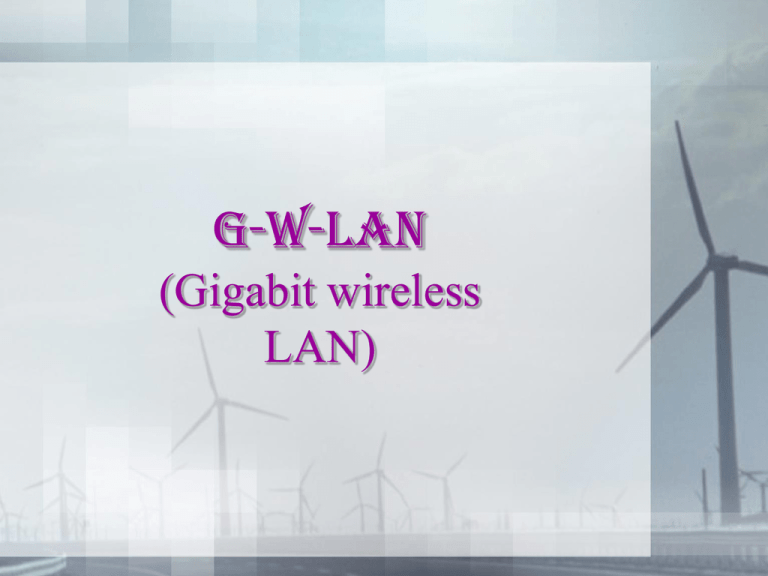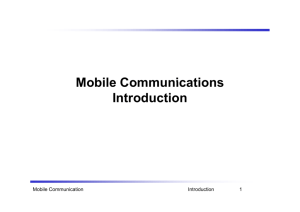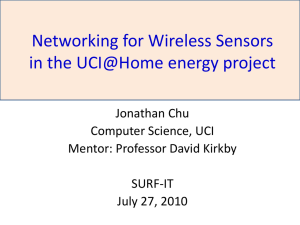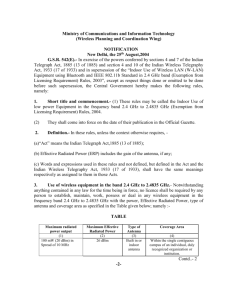Wireless LAN Overview
advertisement

G-W-LAN
(Gigabit wireless
LAN)
Agenda
•
•
•
•
•
Problem Definition 2-3
Background 3-5
Requirements
Detailed Description of 3issues 10-15
Sol for issues --- describe method in
Lit. Ser. 2-5
• Pro’s & Con’s for each method
including the comments 2-3
• Comparison W.R.T. background 2-3
• Conclusion 4-10
Outline: •
•
•
•
•
•
•
•
•
What is G-W-LAN?
Why G-W-LAN?
What is it motivation?
What is it’s motto?
What is the amount of work done in this
area?
Is there any earlier deployment of the
similar type?
What kind of work/research going on in
this area?
What are existing challenges/bottlenecks
in this area?
Are there any future challenges?
What is GWLAN?
• What is WLAN?
• How it came into existence?
• What protocol is used in WLAN?
What is its Architecture of WLAN?
• What are the problems in WLAN?
• Is there any standards?
Overview of WLAN
(Journey/path towards GWLAN)
Wireless LAN Evolution
1945
1986
1990
1995
1997
1999
1999
2000
spread spectrum technology used
early WLAN products on market
IEEE 802 initiates WLAN standard
ETSI specifies 20Mbit/s HIPERLAN
IEEE 802.11 2 Mbit/s WLAN standard
WECA checks product compliance
IEEE 802.11b 11 Mbit/s WLAN standard
WLANA established to educate market
Radio Free Space Propagation
Pr
=
Pt
2
\
4
r
Gr Gt
r
Tx
Pt = transmit Power
Gt = Antenna Gain
Rx
Pr = Receiver Power
Gr = Antenna Gain
Multipath Distortion
echo
Tx
echo
echo
Rx
t
Fading Effects
Tx
Rx
position
Shadowing
Rx
Tx
shadow
Rx
Radio Indoor Propagation
Attenuation (dB)
80
n = 3.7 (Retail)
70
60
Loss o< [distance]
n
n = 3.3 (Office)
50
40
n = 2 (Free Space)
30
20
10
0
1
10
100
Distance (m)
Radio LAN Capabilities
Mbit/s
Metres
250
200
120
100
In-building Range
80
150
Bandwidth
60
100
40
50
20
0
0
900 MHz 1.8 GHz
2.4 GHz
5.6 GHz 17GHz
24 GHz
60 GHz
IEEE 802.11 WLAN Architecture
Higher-Level Protocols
Wireless MAC
Data Link
Layer
Wire Equivalent Privacy
PHY 1
FH-SST
PHY 2
DS-SST
PHY 3
Infra-Red
Physical
Layer
Direct Sequence Spread Spectrum (DSSS)
amplitude
amplitude
freq
baseband signal
freq
transmitted signal
Random
Spreading
Code
amplitude
transmission
amplitude
freq
signal recovery
freq
received signal
Frequency Hopping Spread Spectrum
(FHSS)
amplitude
amplitude
freq
baseband signal
freq
transmitted signal
Random
Hopping
Sequence
amplitude
transmission
amplitude
freq
signal recovery
freq
received signal
Infra-Red LAN Capabilities
Speed
(Mbit/s)
10
docking
station
Directed
Point-to-Point
Building-to-Building
1
Diffuse
10
100
1000
Distance
(metres)
IEEE 802.11 WLANs
•
•
•
•
•
•
•
spread spectrum & IR supported
2.4 GHz ISM band for world-wide
CSMA with Collision Avoidance
initially 1+ 2 Mbit/s raw data rates
~70m in-building range @ 100mW
wire-equivalent privacy mode
power management facility
Supported Topologies
backbone network
base
station
Peer-to-Peer
base
station
Hierarchical
802.11 Wireless LAN Family
• 802.11 Original Wireless LAN in 2.4 GHz band
• 2 Mbit/s with poor signal fallback to half rate
• supports ad hoc & infrastructure configurations
• 802.11a Enhanced Wireless LAN in 5 GHz band
• 54 Mbit/s peak bit rate supported
• 27 Mbit/s average throughput
• 802.11b Enhanced Wireless LAN in 2.4 GHz band
• 11 Mbit/s with poor signal fallback to half rate
• 4-5 Mbit/s average throughput
802.11 Wireless LAN Family
• 802.11e WLAN QoS Enhancements
• introduces QoS facilities to support voice/video
• designed to support 802.11a and 802.11b
• also improves mobile and nomadic use
• 802.11g Higher-speed WLAN in 2.4 GHz band
• extends 802.11b to 20-54 Mbit/s via Orthogonal FDM
• backwards-compatible with 802.11b devices
• 802.11h Higher-speed WLAN in 5 GHz band
• extends 802.11a for European CEPT frequencies
802.11 Wireless LAN Family
• 802.11i Enhanced WLAN Security
• definition of powerful wireless LAN security
• encompasses 802.1X, TKIP & AES protocols
• includes authentication and encryption
• 802.11n High Throughput WLAN
• targeting bit rates >100 Mbit/s, up to 250 Mbit/s
• both 2.4 GHz and 5 GHz band being considered
• standardisation completion planned for end 2005
• Future Generation WLAN Think Tank
• proposal for Gigabit WLAN in 56+GHz bands,
with lower cost than GBE over cable for 2005-6
IEEE 802.11 standards and HiperLAN2
Evolution of Gigabit Wireless LANs
Phase 3
Enterprise grade
Gigabit Ethernet
wireless-to-the-desktop
Enterprise
Gi
Phase 2
54M @
802.11g 2.4GHz
SMEs
security
QoS
Phase 1
54M @
2M @
Home/
SOHO
802.11i
802.11e
802.11a 5.7GHz
2.4GHz 802.11b
11M @
2.4GHz
802.11
2000
2005
Fi
Motivation for GWLAN: • Increase in the use of wireless devices.
• Significant growth in Wireless local area
networks (WLAN’s) as they provide a
data-based complement to wireless voicebased cellular networks.
• Resulted in
– Raise in demand for high-speed multimedia
data communications, such as a huge data file
transmission and real-time video streaming.
– Markedly increasing wireless transmission
with 1Gbps and beyond data rate became very
essential.
Existing Issues: : • Delay Spread in Radio Channel
(Asymmetric Equalization) frq.
• MIMO.
• High Capability Antennas.
Other Issues: • Compatibility with different
application and devices.
• Hardware Synchronization /
Hardware Design Aspects
– Hardware at the end user (Rx)
– Hardware at the Base Station (Tx).
• Handoff (interoperability in the Local
LAN with different AP’s).
• Cost of Design, Deployment and
Maintenance.
Other challenges: •
•
•
•
•
Coverage Area (Signaling distance).
Through-put.
Power.
Robustness.
Quality of Service (Error Rate,
Packet lost, etc).
• Performance.
• Co-Existence with existing system.
• Issues pertaining to Outer door and
indoor environment.
Roadmap – WLAN
Deployment scenarios
Home environment
• Video streaming
–
–
–
–
•
•
•
•
20 MBit/s high quality
3 hops
MAC overhead
100 MBits/s
Internet download: 100 Mbit/s
Audio (multi hop): 30 MBit/s
Multiple users & applications
Highly bursty traffic
– 1 GBit/s required
• Self-configuration, zero maintenance
• Ad-hoc and multi-hop capabilities
Key challenges: ease of use, robustness, QoS
Enterprise environment
• WLAN brought wireless
interconnection to the office
– Work becomes detached from the
desk
• 100baseT and 1000baseT are
state-of-the-art
– Wireless Gigabit required to match
enterprise demands
• VoIP and video conference
systems necessary in enterprise
environments
– QoS support is mandatory for
wireless LAN in the office
Key challenges: throughput, quality of service,
security/privacy
Public Access [HotSpot]
ISP provide decentralized
internet (and intranet) access
Hot spot coverage
High numbers of users
(e.g. up to 50 users at 80m2)
Dramatic variation of maximum
transmission bit rate during
hand-off (vertical & horizontal)
Highly flexible MAC required
Differing service requirements
Key challenges: flexible high speed MAC, trade range vs. rate
Public Access – Trains and Highways
• Internet access in trains and
cars
• Hot spot coverage along
railway tracks and highways
• Access points in 100-300m
distance
• LOS conditions
– High Doppler shift, low
Doppler spread
– “Standard” hot spot solutions
partly applicable
Link Layer Options
“Conventional” Radio
Communications
=>WG5 White Paper on
MIMO-OFDM TDD Physical Layer
Ultra Wideband
=>WG5 White Paper on
UWB: Technology and Future
Perspectives
Millimeter Wave Communications
=>Upcoming WG5 WWRF Briefing
Optical Communications
=>WG5 White Paper on
Optical Wireless Communications
Main Challenges
• User data rates up to 100 MBit/s, peak data
rate ~1 GBit/s
• Efficient and flexible high speed MAC with
QoS
• Auto-configuration, ad-hoc and multi-hop
capabilities
• Ease of integration in IP based backbone
• Coexistence with other systems
Technology Trends
• Baseband (focus on “conventional” radio communications)
–
–
–
–
Spatial diversity and multiplexing techniques
Multi-carrier modulation
Turbo principle – iterative decoding, equalization, etc.
Adaptive modulation and coding
• MAC
– Avoid short data burst to minimize MAC overhead
– Superposed signaling (separate high rate from low rate data)
– QoS support
• Cross-layer optimization
• Implementation issues
– PAPR reduction, baseband compensation for “Dirty RF”
Technology trends: Baseband techniques
• OFDM to efficiently equalize frequency selective
channel
– Enabler for high MAC granularity (OFDMA)
– Preamble design – Guard interval vs. IOTA/OQAM
– Implementation issues – PAPR, phase noise, etc.
• MIMO to attain high spectral efficiency
– Receiver processing – Linear, PIC, SIC, ML-like
– Transmitter processing – Linear, THP, Lattice Precoding
– Channel estimation – More pilots needed
• Iterative processing to minimize SNR
requirements
– Turbo equalization, data aided channel estimation, etc.
– Processing power vs. RF requirements trade-off
Technology trends: MAC issues
• Efficiency (long PHY bursts short MAC PDUs)
–
–
–
–
Fast ARQ, Hybrid ARQ
New metrics for Link Adaptation
Packet aggregation, superposed signaling
Multi-dimensional resource allocation (Time, Frequency,
Space)
• Flexibility, centralized vs. distributed scheduling
– Coordinated on-demand resource allocations
– Ensure high efficiency and low delay in high load regime
– Distributed allocation mechanisms (ad-hoc capabilities)
• Self-configuration
– Topology & coordination management
– Efficient routing schemes with good dynamic properties
Technology trends: Cross-layer optimization
Combined optimization throughout the network
stack:
• PHY aware scheduling & routing
– Channel conditions need to be taken into account
at higher layers
– Multi user scheduling for throughput maximization
(MIMO Multi User)
• Quality of Service mechanisms
– Resource allocation based on service level
agreements
– QoS aware error control
Standardization
• IEEE 802.11a (WLAN)
– Data rates 54 MBit/s
– OFDM, carrier at 5 GHz
– PHY almost identical to ETSI/BRAN HiperLAN/2
• IEEE 802.11n (high throughput study group)
– Data rates 108-320 MBit/s (100 MBit/s on MAC SAP @ 20
MHz BW)
– MIMO-OFDM, carriers at 2.4, 5 GHz
• IEEE 802.15 (WPAN)
– Relevant subgroup: 802.15.3/3a (High rate, Alternative
PHY)
– PHY data rates up to ~ 500 MBit/s
– Multi-band OFDM, DS-CDMA
– Carriers at 3.5 – 10 GHz, ultra wide bands
Gigabit Wireless Applications Using 60 GHz Radios
Deployment
• Smaller Range
Medium Range
Large Range
• Technology
– License-free 60 GHz radios have unique characteristics that
make them substantially different from traditional 2.4 GHz or
5 GHz license-free radios, as well as setting them apart
from licensed-band millimeter-wave radios. The attributes of
60 GHz radios that arise from these characteristics include:
· License-free deployment
· Multi-gigabit operation
· Ability to co-locate multiple radios on a single roof or mast
· Immunity to interference
· Security from signal interception
· Ease of installation
Factors
•
•
•
•
Rainfall Limitations.
Oxygen Absorption.
Narrow Beams Antennas.
License-Free Spectrum.
•
•
•
•
•
•
•
•
•
•
•
•
•
•
•
The 60 GHz band is an excellent choice for high-speed Internet, data, and
voice communications
offering the following key benefits:
· Unlicensed operation - no need to spend significant time and money to
obtain a license
from FCC
· Highly secure operation - resulting from short transmission distances due to
oxygen
absorption and narrow antenna beam width
· Virtually interference-free operation - resulting from short transmission
distances due to
oxygen absorption, narrow antenna beam width, and limited use of 60 GHz
spectrum
· High level of frequency re-use enabled - communication needs of multiple
customers
within a small geographic region can be satisfied
· Fiber optic data transmission speeds possible - 7 GHz of continuous
bandwidth available
compared to <0.3 GHz at the other unlicensed bands
· Mature technology - long history of this spectrum being used for secure
communications
· Carrier-class communication links enabled - 60 GHz links can be
engineered to deliver
"five nines" of availability if desired
Comparative Summary of FSO, 60GHz and Hybrid Systems
Conclusion
Main challenges
• Extremely high peak data rates
– High spectral efficiency requirements on PHY
– Efficient and flexible high speed MAC
– Cross-layer optimization
• Integration into B3G, coexistence with other
systems
• The realization “Wireless Gigabit” requires
challenges on all layers of the network stack
to be tackled – jointly.
References: WWRF documents
WWRF WG5 White Paper “New Radio Interfaces for Short
Range Communications”
WWRF Book of Visions 2001: http://www.wireless-worldresearch.org/
Publications
Karine Gosse et al., “The Evolution of 5 GHz WLAN Toward
Higher Throughputs”,
• IEEE Wireless Communications Magazine, December 2003
Projects
WINNER: http://www.ist-winner.org/
BROADWAY: http://www.ist-broadway.org/
Chinese FuTURE Project: http://future.863.org.cn/
Wigwam: http://www.wigwam-project.com/
Standardization and Alliances
IEEE 802.11,15,16,20: http://www.ieee802.org/
ETSI BRAN HiperLAN/2:
http://portal.etsi.org/bran/kta/Hiperlan/hiperlan2.asp
ARIB MMAC: http://www.arib.or.jp/mmac/e/
•
•
•
•
•
•
•
•
•
•
•
•
•
•
•
•
IEEE Std 802.11, 2004”Integration of Hybrid Fibre Radio and IEEE 802.11 WLAN network” Kenneth K L. Ho and J.
E. Mitchell
IEEE, VOL. 44, NO. 8,”Giga bit indoor wireless communication with Direction Antenna” Peter F. Driessen, Senior
Member, IEEE
Broadband U-NI1 Wireless Data N. Weste, D. Skellern and T. Percival*Electronics Department, Macquarie
University, Sydney, Australia *Division of Telecommunications and Industrial Physics, CSIRO, Sydney, Australia.
IEEE Std 802.11, 1999 Edition: Part II: Wireless LAN Medium Access Control (MAC) and Physical Layer (PHY)
Specifications.
3. IEEE Std 802.11b-1999 (Supplement to IEEE Std 802.11-1999): Part II: Wireless LAN Medium Access Control
(MAC) and Physical Layer (PHY) specifications: High-speed Physical Layer Extension in the 2.4 GHz.
4. IEEE Std 802.11a -1999 (Supplement to IEEE Std 802.11-1999): Part II: Wireless LAN Medium Access Control
(MAC) and Physical Layer (PHY) specifications: High-speed Physical Layer in the 5 GHz Band.
5.Pierre A. Humblet, Serge Huthuin, Louis Rame “A MULTIACCESS PROTOCOL FOR HIGH-SPEED WLAN” French
Patent, Dec. 2002
AN SDMA ALGORITHM FOR HIGH-SPEED WLAN. Patrick Vandenameele' Liesbet Van Der Perre Bert Gyselinckx
arc Engels Hugo De Mans Interuniversity Micro Electronics Centre (IMEC). Kapeldreef 75,3001 Heverlee – Belgium
D. J. Skellern et al. A High-speed Widess LAN, IEEE Micro, vol. 17, no. 1, pp. 40-7, Jan.-Febr. 1997
ISSUES IN HIGH-SPEED WLANS David J. Skellern, Alex C. K. Lam * and Neil Weste Radiata Communications Pty.
Ltd.*Macquarie University North Ryde, NSW, Australia
Challenges and Opportunities in Broadband and Wireless Communication Designs Jan M.Rabaey', Miodrag
Potkonjak2, Farinaz Koushanfar', Suet-Fei Lit, Tim Tuan' EECS Department, University of California, Berkeley, CA
94720 {* CS, EE} Departments, University of California, Los Angeles, CA 90095
IEEE Transactions on Consumer Electronics, Vol. 48, No. 3, AUGUST 2002 “A MEASUREMENT BASED
FEASIBILITY STUDY OF SPACE-FREQUENCY MIMO DETECTION AND DECODING TECHNIQUES FOR NEXT
GENERATION WIRELESS LANS “Robert Piechocki, Paul Fletcher’, Andrew Nix, Nishan Canagarajah and Joe
McGeehan.
“1.25Gbps Wireless Gigabit Ethernet Link at 60GHz-Band”Keiichi Ohata, Kenichi Maruhashi, Masaham Ito, Shuya
Kishimoto, Kazuhiro Ikuina
“SOC Design of an IF Subsampling Terminal for a GigabitWireless LAN with Asymmetric Equalization” Holly
Pekau, Joshua K. Nakaska, Jim Kulyk, Grant McGibney, James W. Haslett.
“Performance Analysis of the Out-of-Band Signaling Scheme for High Speed Wireless LANs Juki Wirawan Tantra,
Chuan Heng Foh, Giuseppe Bianchi, Ilenia Tinnirello.
“A 60 GHz Transceiver with Multi-Gigabit Data Rate Capability” Bruce Bosco, Steve Franson, Rudy Emrick, Steve
Rockwell, John Holmes





